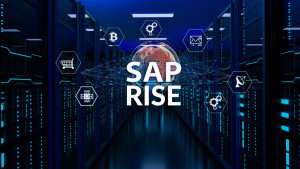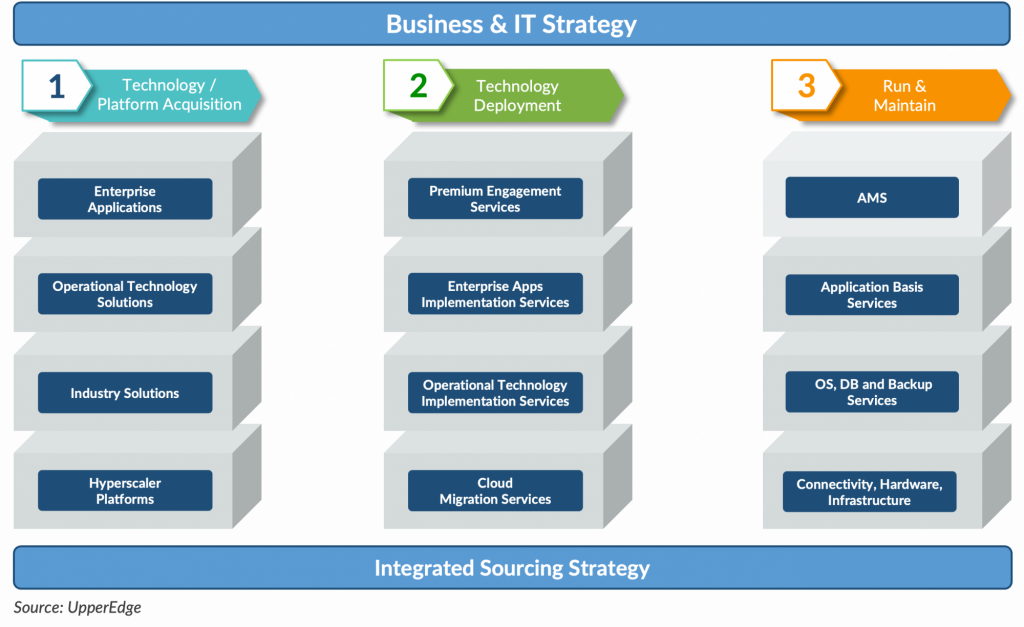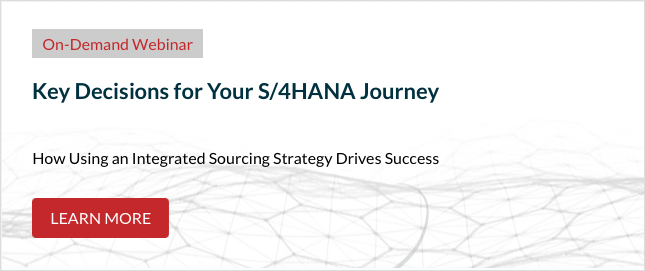- Chip Hanna
- Reading Time: 7 minutes

Customers have watched SAP evolve RISE to better fit their needs since it first hit the market. Since then, we have seen companies successfully implement RISE and we have also seen some realize that RISE is not the best fit.
If RISE does seem to align with your organization’s goals and objectives, it is critical that you understand how to approach your digital transformation and what pre-determined decisions come with choosing RISE at the outset of your transformation.
The Traditional Digital Transformation Journey
Before diving into how RISE has shifted the digital transformation journey for many customers, you should understand what the traditional transformation process looks like and how this process has been historically viewed by organizations as they are trying to drive new business outcomes through technology.
Typically, this traditional approach starts with understanding what the business strategy and objectives are – the problem you are trying to solve, revenue you are trying to drive, and efficiencies you are trying to create. This is often done internally with customers. Other times, it involves leveraging a third-party to provide strategic advice. Regardless of the approach you choose, this comes together in a set of strategies and objectives meant to achieve your preferred outcome.
With that, you obviously need to develop a business case. This includes thinking about your ROI, what your spend profile will look like, and how you will come to a consensus on outcomes. You also need to be thinking about the investments that need to be made and the timing of the project to reap those benefits.
The next step is to develop your requirements. The logical progression is sourcing the software technology to enable your business and help you evolve exponentially, move quickly, be more agile, respond to market forces, and serve your customers and clients. Whether you are looking to upgrade to S/4HANA or are looking at a competitive environment for your ERP platform, you will want to go to market and negotiate the software deal.
Once you’ve purchased the software, you need to implement it, and that is primarily done by leveraging a partner like PwC, Accenture, or Deloitte. That partner needs to be selected either through an incumbency or through a competitive process so you can determine how you are going to implement your software and when you are going to implement it.
Next, you need to understand where this technology is going to reside, and how it is going to be cared for, maintained, upgraded, and serviced for your internal and external clients to be successful. Many people are now looking at a cloud-first methodology. This means you need to be thinking about what entity is going to host your software after it has been implemented and how are they going to maintain the infrastructure and the underpinning elements that are going to run the software from a technical perspective. Who is going to be your application support partner or your AMS partner? You need someone who will take care of all your upgrades, fixes, and customizations as the requirements evolve throughout your transformation.
As you can see, this is the traditional, single-thread process. It is very linear, and sometimes, without intending to, some of the decisions on your implementation or hosting partner are made much earlier in the process than they should be. We see companies realize that they did not have the opportunity to think through the strategy that leads to unintended consequences by looking at the decision-making and the transformational process through this more linear lens.
Developing an Integrated Sourcing Strategy
To work through all the decisions that need to be made at the outset of your transformation, it is important to move away from the traditional approach and develop an integrated sourcing strategy. Instead of taking a linear approach to your transformation, an integrated sourcing strategy is multi-dimensional – it allows you to look at your transformation from every possible angle.
All the different elements of an integrated sourcing strategy have an implication for your future state, and these implications are based on the decisions you make today. It will impact how your transformation and decisions will evolve for you next week, next month, and throughout the entirety of your digital transformation journey.
There are three pillars to an integrated sourcing strategy:

- Technology / Platform Acquisition
Unlike the traditional approach, you need to be thoughtful across enterprise applications, operational technology solutions, industry solutions, and hyperscaler platform decisions.
Enterprise applications are an easy fit here; you need to know what you are going to source on the application side at the outset of your transformation. For businesses focused more on manufacturing, finding operational technical solutions also seems like an easy decision because they are embedded in the way you do business.
There are also industry solutions to consider. SAP has made specific investments in certain industries to embed the needs of these industries into their solutions. The SIs are also developing their own capabilities in particular industries, creating some co-opetition and solidifying the need for you to embed these solutions into your environment.
Lastly, you need to think about where your platform is going to land. Who are the hyperscaler partners you are going to leverage? Do you already have a private cloud relationship? These factors need to be considered early in your transformation because they could inform decisions you make down the line.
- Technology Deployment
Now that you know what you are going to buy and where you are going to land that technology, you need to actually get the technology to that destination. With SAP, there are premium engagement services that provide project management oversight specifically for this.
There are specific capabilities that SAP can bring to bear for landing your technology and moving your platform forward while also implementing your enterprise applications. This is the straight-up SI work that companies would do with operational technology services before finally moving and migrating to the cloud.
- Run and Maintain.
Finally, you must look at how all of this is going to come together and run. You need to think about the AMS component for down the road once you’re deployed. You also must consider the application basis services as well as the database, OS, and backup services from a “run and maintain” perspective. Finally, you must look at the infrastructure – specifically the connectivity, the hardware, and the datacenter infrastructure.
When you think about an integrated sourcing strategy, it is important to think about it in these pillars vertically as they relate to each step, but also horizontally. RISE clearly requires you to be thinking multi-dimensionally as you start to finalize and execute your integrated sourcing strategy to ensure you set yourself up for success as you move through your transformation.
How Does RISE Work with An Integrated Sourcing Strategy?
- Technology / Platform Acquisition
If you choose to go down the RISE path, you have made some specific decisions around enterprise applications, industry solutions, and hyperscaler platforms that led you to RISE. By picking RISE, you have likely made some conclusions and some preselected outcomes per these three elements of your platform acquisition. For example, when it comes to the enterprise application decision, this seems obvious because RISE and S/4HANA are, at their core, an ERP system.
If you choose an industry solution to leverage that does not include SAP, you need to be mindful that SAP has very specific business practices around digital access. You need to be aware of what those potential exposure costs will be in the context of these industry solutions and whether they are partner-provided through an SI or a best-of-breed solution. You also need to be mindful of how you consider your industry solutions through the context of your platform technology as well as your contractual and financial relationship with SAP.
You have also likely made decisions on who would be considered as to host your applications. SAP has been flexible; they have provided the ability for customers to leverage AWS, Google, or Azure. That is important to note because this narrows the possible field of contenders to three, which are obviously capable of doing the job. However, this has implications as to where you currently are and decisions you have already made for your go-forward cloud strategy.
Additionally, you must be mindful of your existing relationships with AWS, Google or Azure as you think about RISE. There are some nuances to the commercial benefits and detriments of making a choice that are important to work through from the outset.
- Technology Deployment
From the technology deployment side, choosing RISE means SAP will position themselves at a point of influence and control on your move to RISE by way of premium engagement services. This includes MaxAttention and ActiveAttention, along with other premium engagement services, that SAP would want to bring to the table not only for the revenue opportunity, but also to make sure to embed themselves within your organization as you go through this transformation.
This ends up creating an internal sales organization for SAP to influence your ultimate roadmap and your investments with SAP. Can SAP actually deliver value here? Of course – they have engineers, technicians, and experts who know RISE inside and out. But it’s important to understand what their value is and what their objectives are.
It’s equally important to note that often, these services are not informed by what your internal people are doing, what your hyperscaler may be doing, or what your SI provider may be doing. The biggest disconnect we see is the gap between what the SI is going to be doing and what SAP is going to do.
Synergizing and structuring that discussion helps companies determine what the right scope is. This is critical beyond understanding the rates provided and whether the commercial benefits around them are competitive or not.
- Run and Maintain
On the run and maintain side, RISE includes application basis services as well as the database, OS, and backup services. It also includes the connectivity, hardware, and infrastructure elements. When you already have a cloud strategy and a cloud provider, it is important to understand how these decisions around the run and maintain component impact those existing relationships.
It is also critical to understand that in its purest sense, RISE does not provide AMS services, so you are going to have to bring in someone to provide those services for you. There are different stakeholder groups that have ownership over these different areas, and if they are not pulled in early as it relates to the strategy, timing, and outcomes, you are going to have a lot of confusion and a lot of unknown assumptions where people are not aligned on the outcome.
The Bottom Line
If you choose RISE today in your sourcing for technology, the elements discussed under each pillar predetermine certain decisions that are going to be made in the technology acquisition, technology deployment, and the run and maintain areas. That is why it is crucial to take a multi-dimensional approach via an integrated sourcing strategy to ensure you get the chance to make the decisions you need to fulfill your goals and objectives.
Comment below, find my other UpperEdge blogs and follow UpperEdge on Twitter and LinkedIn. Learn more about our SAP Compliance and Audit Advisory Services.
